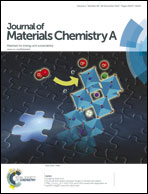Complementary solvent additives tune the orientation of polymer lamellae, reduce the sizes of aggregated fullerene domains, and enhance the performance of bulk heterojunction solar cells†
Abstract
In this study we employed 1-chloronaphthalene (CN) and 1,8-diiodooctane (DIO) as binary additives exhibiting complementarily preferential solubility for processing the crystalline conjugated polymer poly[bis(dodecyl)thiophene-dodecyl-thieno[3,4-c]pyrrole-4,6-dione] (PBTC12TPD) and the fullerene [6,6]-phenyl-C71-butyric acid methyl ester (PC71BM) in chloroform. Using synchrotron grazing-incidence small-/wide-angle X-ray scattering and transmission electron microscopy to analyse the structure of the PBTC12TPD–PC71BM blend films, we found that the binary additives with different volume ratios in the processing solvent allow us to tune the relative population of face-on to edge-on PBTC12TPD lamellae and the size of PC71BM clusters in the blend films; the sizes of the fractal-like PC71BM clusters and the aggregated domains of PC71BM clusters increased and decreased, respectively, upon increasing the amount of DIO, whereas the relative ratio of face-on to edge-on PBTC12TPD lamellae increased upon increasing the amount of CN. When fabricating the photovoltaic devices, the short-circuit current density of the devices with the PBTC12TPD–PC71BM active layer having been processed with the binary additives is higher than that of the device incorporating an active layer processed without any additive. As a result, the power conversion efficiency of a device incorporating an active layer of PBTC12TPD–PC71BM (1 : 1.5, w/w) processed with binary additives of 0.5% DIO and 1% CN in chloroform increased to 6.8% from a value of 4.9%, a relative increase of 40%, for the corresponding device containing the same active layer but processed without any additive.


 Please wait while we load your content...
Please wait while we load your content...